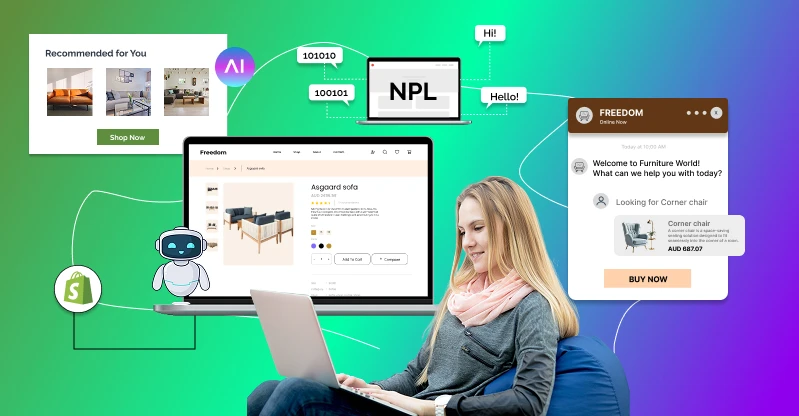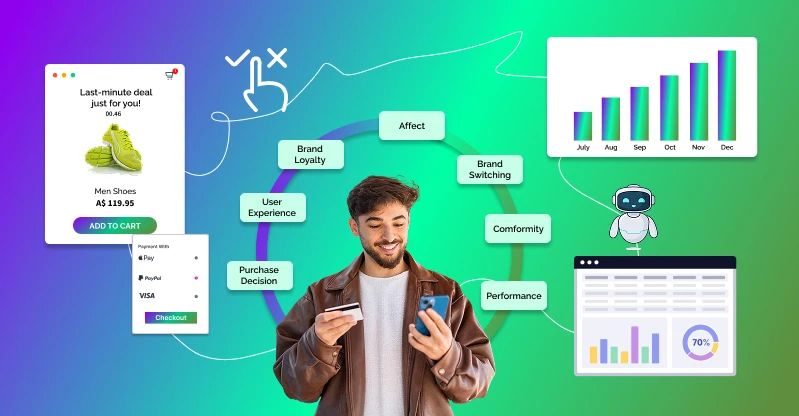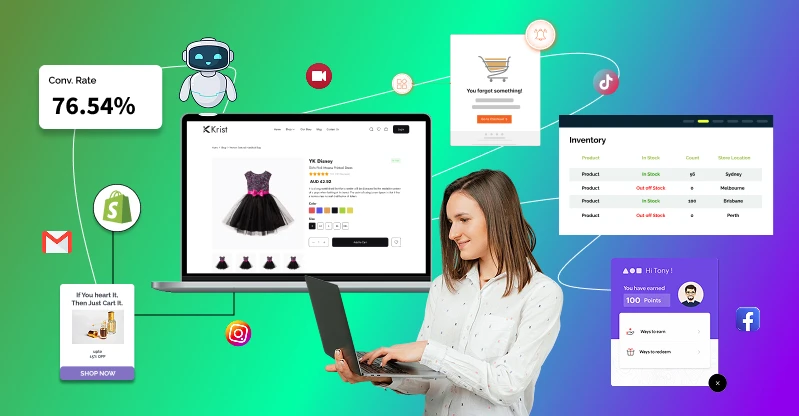How to Grow Your Shopify Store in Australia with AI Analytics?

The Australian online retailing industry has been expanding rapidly in recent years, with Shopify being one of the popular platforms used by online retailers.
Online retail in Australia makes over $63 billion in annual sales, and the figure is expected to grow with rising smartphone adoption, faster broadband speeds, and changing customer behaviour.
With such a competitive market, having a Shopify store is not sufficient—what you need is actionable insights that will give you a definite understanding of your consumers, maximise your marketing, and push sales. That is where AI analytics enters the scene.
AI analysis employs machine learning, natural language processing, and predictive modelling to build a better picture of customer behaviour and store data. To Australian Shopify store owners, it’s survival or success online.
In this blog, we will discuss how you can utilise AI analytics to propel your Shopify store in Australia, right from real-life strategies, advantages, and tools that can help you out.
Why AI Analytics Is Essential for Shopify Stores in Australia
Let us first learn why AI analytics is critical in the Australian market:
Heavy Retail Competition
With big guns like Amazon, Catch, and eBay competing with small to medium Shopify stores, AI analytics allows you to determine niche opportunities, provide individual experiences, and keep existing customers coming back.
Differential Consumer Behaviour
Revealing different shopping behaviours among Australians—free shipping, eco-friendly packaging, and BNPL facilities are most desired. AI analytics can catch up on these and make more intelligent decisions.
Increasing Customer Expectations
With the help of AI assistants such as ChatGPT and Google Gemini, consumers are waiting patiently for instant and personalised interactions. AI analytics allows you to understand beforehand what the customer needs and offer it even before they demand it.
Scaling
As your growing Australian Shopify business, AI analytics allows you to handle data effectively while scaling operations without ever losing sight of the customer experience.
Major Ways of Employing AI Analytics for Shopify Growth
AI analytics is game-changing for Australian Shopify stores since it enables businesses to break away from guessing and towards informed decision-making. The following are some strong ways it can be used to drive growth:
Personalised Customer Experiences
Personalisation is the key to eCommerce today. AI-driven analysis follows customer behaviour, demographics, and past purchase history to suggest what they are likely to purchase. For instance, if Sydney customers tend to purchase green skincare, then AI can suggest a vegan moisturiser or bamboo face towels. It increases average order value and builds loyalty.
Smart Inventory Management
Demand forecasting is a major factor for any brand, no matter if it’s finding the right products at the right time. AI-driven demand forecasting allows you to forecast peak periods. For example, in summer or winter, the clothing for the other session is not needed, and it can restock the inventory accordingly. This prevents the twin evils of stock-outs and overstocking, which ultimately saves money while meeting customer demands.
AI-Optimised Marketing Campaigns
Ad campaigns are carried out to a greater extent if driven by an AI mind. Depending on which geographies, channels, or communications are more effective, AI assists you in optimising ad spend. For example, if the ads are more effective in Melbourne than Brisbane, AI technology can suggest more ad spend in Melbourne for improved ROI.
Improved Customer Service
The new-age customers look for faster and accurate responses to meet their different expectations. This is why the need for AI chatbots is becoming popular to match their diverse demand.
These bots are highly analytics-driven and can respond quickly to any kind of customer queries. Starting from addressing delivery issues, to providing instant product suggestions, everything can be done easily by these intelligent chatbots.
For example, if a fashion store uses AI-based chatbots to eliminate cart abandonment via 24/7 support, it will be helpful for delivering a better customer experience.

Dynamic Pricing Strategies
Pricing is the sales break-even. AI tracks what the competition is paying, how customers are acting, and how demand rises and falls and suggests real-time price changes to maintain your products’ competitiveness without sacrificing profitability.
Predictive Retention
Repeat customers are purchased at a lower price than new customers. AI analytics may detect troublesome shoppers—i.e., the customer who has not shopped in 90 days—offer them promotions or emails and bring them back, increasing customer lifetime value.
Anti-Fraud
eCommerce selling is increasingly being weighed down by unauthorised transactions. This is creating major issues for customers’ trust and loyalty. With the help of AI-powered tools, this problem can be solved. As it can detect dubious activities like repeated failed transactions or suspicious IP addresses, so you can prevent chargebacks and lock up your profits.
Website Experience Optimisation
AI monitors the visitation of your Shopify store by customers. When checkout cart-abandoning occurs, AI reports will suggest simplifying payment processing or offering local BNPL such as Afterpay. This boosts conversion rates but gives up bounce rates.
Best AI Tools Available for Shopify Australia Stores
Some AI-powered tools are capable of assisting Shopify vendors in Australia with better, faster, and more profitable decisions.
Shopify Inbox + AI
It is Shopify’s feature that combines customer conversations with intelligence. With the offering of AI-powered responses, it can automatically respond to routine questions, provide product recommendations, and optimise live chat.
Klaviyo
This tool is popular among Shopify merchants due to its strong email and SMS automation. It leverages AI to personalise the messages highly on the browsing and buying history of the customer. For instance, it will send a triggered abandoned cart reminder that is highly personalised by shopper interest.
AdRoll
This tool is a marketing and retargeting specialist. Its AI product tracks campaign performance across social, email, and the web, and reallocates budget to the highest-performing sites. This maximises every marketing dollar spent.
Inventory Planner
It saves Shopify merchants money on expensive stockouts. With AI demand forecasts, it keeps your best-sellers in stock and minimises excess storage space on low-demand products.
Tidio AI ChatBot
It offers continual customer support, not only answers questions, but it also learns from previous conversations with consumers, which helps to understand the entire situation to continually improve user engagement cost-effectively.
Prisync
It provides Shopify stores with a competitive pricing edge. It provides dynamic price modifications based on competition pricing and AI algorithms, allowing you to remain competitive while maximising earnings.
These tools collectively comprise a strong Australian Shopify merchant ecosystem that ranges from customer and marketing services to price and stock management.
Australian eCommerce’s Future of AI Analytics
The use of AI in Australian eCommerce will only increase. Some of the most important future trends to watch out for are as follows:
Deeper Personalisation
AI will mature to provide a hyper-personalised experience—right down to personalising homepages for unique shoppers. An explainer example is that a current buyer in Perth can be presented with green packaging of products, and a current buyer in Sydney can be presented with technology offers.
Voice and Conversational Commerce
With smart assistants Alexa, Siri, and Google running homes, voice buying will become the new fad. AI acumen will drive Shopify stores to personalise voice search for products.
More Integration with BNPL Providers
Australians are fond of buy-now-pay-later solutions like Afterpay and ZipPay. AI will assist in reviewing customers’ pay history and streamlining checkout procedures with BNPL providers.
AI-Driven Supply Chain Optimisation
Logistics management is highly necessary for any business, and with the help of AI, the brands can get smarter logistics. It can range from forecasting late deliveries to optimising shipping routes. This will lower delivery costs and enhance customer satisfaction.

Sustainability Insights with AI
Green shopping is most popular in Australia. AI analysis will enable companies to quantify their sustainability trace, i.e., monitor carbon traces per sale.
Augmented Reality (AR) Shopping Experience
AR will be driven by AI to enable customers to “try before they buy.” Furniture shops, for instance, can enable customers to visualise where a couch would go in their Melbourne flat.
These shifts will not just alter the character of Shopify stores but also redefine Australian customer expectations.
Conclusion
AI analysis is no longer optional, but a requirement for Shopify store owners in Australia to grow economically. From demand forecasting and personalisation to loyalty and dynamic pricing, AI provides actionable insights that drive growth.
Whether you are an Australian eCommerce store owner or a Melbourne local boutique, your shop and customer experience can be improved with AI analysis at your disposal.
The earlier the better. The earlier you act, the earlier you will pass the others in Australia’s thriving eCommerce landscape. Connect with a Shopify development partner to implement AI analytics in a better manner to ensure business success.
FAQs
 What is AI analytics in Shopify?
What is AI analytics in Shopify?
AI analytics utilises machine learning and predictive intelligence to analyse customers, market automation, stock optimisation, and customer experience personalisation.
 How does AI analytics help Australia's sales?
How does AI analytics help Australia's sales?
It assists in making customer-like decisions, personalising experiences, forecasting demand, and marketing campaign automation—increasing sales in a moment.
 Is AI analytics costly for small Shopify stores?
Is AI analytics costly for small Shopify stores?
Not necessarily. Certain Shopify applications, such as Tidio, Klaviyo, and Prisync, come with affordable pricing for small-sized enterprises.
 Can AI analytics assist with Australian-specific payment products such as Afterpay?
Can AI analytics assist with Australian-specific payment products such as Afterpay?
Yes. AI can analyse payment patterns and suggest offering domestic BNPL products such as Afterpay or ZipPay to enhance conversions.
 Which are the most employed AI tools for an Australian Shopify business?
Which are the most employed AI tools for an Australian Shopify business?
The most common ones are Klaviyo (marketing), Inventory Planner (inventory planning), Tidio AI Chatbot (customer support), and Prisync (dynamic pricing).




